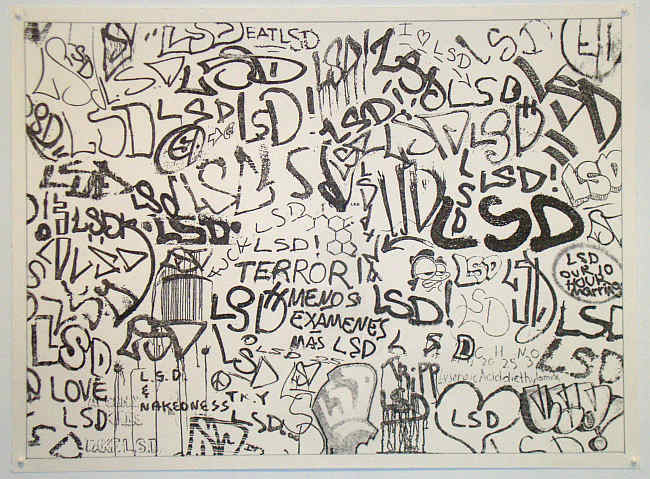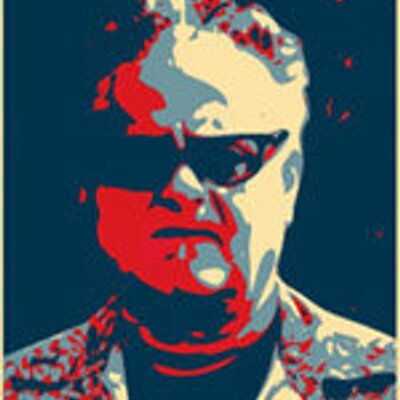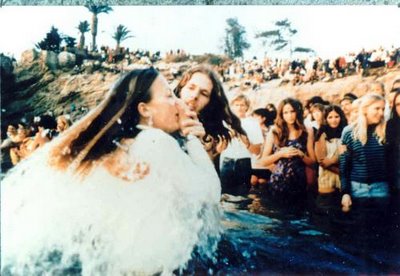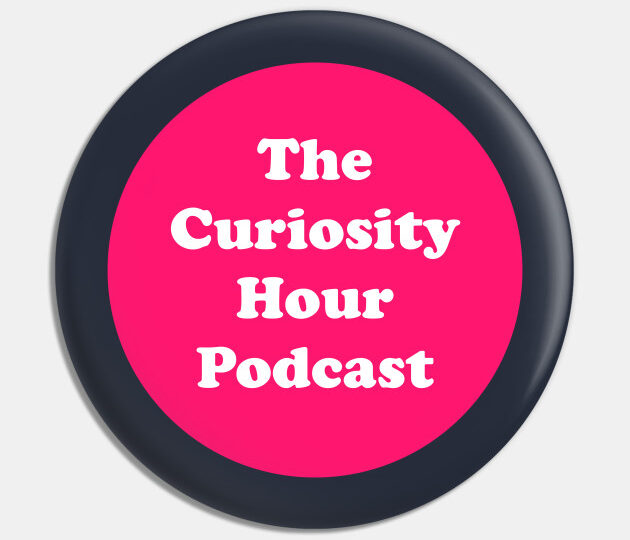
Confessions of a High School Stoner
This essay was later collected in Nomad Codes.
I became a teenager the year Reagan ran for president, and by the time the lizard slid into office, I was already a total stoner. I bonged skunk bud, chased JD with Coke, snorted Beauties, and had dropped my first dose of acid the previous Halloween, tripping to Ummagumma amidst the paisley bedsheets and pillows that lined the loft my friend Bry-Fry knocked together in his family’s garage. Phasing between the reveries of a bookish childhood and the hormone-fueled angst of teendom, my mind liquified, running through the cracks and creases of a suddenly unfolded world of psychedelic culture.
In the last couple of years, that world has seemed closer to the surface, and I don’t think it’s a matter of my own nostalgia. Raves, which restage the Neopagan commingling of a Woodstock I never saw in venues resembling the space stations I never will, are only the greatest and most media-friendly example of youth culture’s desire to tune into trippy frequencies. There are also rappers talking hemp conspiracy theories and crafting stoned-out beats and rhymes, cyberslackers building virtual worlds, prog rockers and jocks dancing in the dust at Lollapalooza. And it’s not just the kids. If you don’t see a connection between brokerage firms’ increasing reliance on virtual reality representations of stock data and the Economist’s pro-legalization cover story, you probably didn’t smoke enough pot in high school. And with the FDA opening the door to psychedelic research at the same time tabloid TV is updating psychedelic scare stories to match the upswing in teen acid use, it’s reassessment time.
But drugs are like sexual pleasures: Experimentation is a prerequisite for judgement. For each of us, certain drugs will become allies, enemies, passing acquaintances but first they must be encountered, knee-deep in the mud of personal history.
Though the timing of my early encounters now seems a bit out-of-hand, the place was certainly more than appropriate: coastal California. Not that my neck of the palms was a ganja paradise. Before I entered junior high, my family moved inland from Del Mar, the mellow, upwardly mobile surf town north of San Diego name-dropped in “Surfing, U.S.A.,” to Rancho Santa Fe, a wealthy and conservative realm of citrus groves, migrant Mexican workers, and geriatrics in golf carts. Stone-cold Reagan country, and me and Senzo Joe would escape into the weed, toking up in so many lemon groves that the sharp tang of citrus peels still conjures up bud.
Pot led me into a tangible world of bubbling micro-perceptions, haunted winds, and hilarious malformations of the data-stream. But pot also gave me something that has stuck with me far longer than the urge to bake the brain: a love of slippage, founded in the realization that altering perception alters the claims reality makes on you. The various social agendas of parents, teachers, and the ghost of God could be sidestepped not only by sullen monosyllables and the worship of unwholesome heavy metal guitarists but by tinkering with consciousness itself. What greater rebellion than rewiring one’s experience of the world?
Parents have reason for concern. At 13, identity is a spell woven from a bursting body, ego defenses and worldviews have yet to congeal, and the prepubescent power of fantasy lurks just below the surface. That’s why kids can travel so far into their headphones, role-playing games, pop star posters, and beat-up copies of The Necronomicon. Toss in a psychedelic and let no one tell you that good weed cannot be a psychedelic and the warp gets deep. Pot lets you see dragons in the clouds again.
I know, because I saw a lot of stuff, zoning out in that bedroom whose every surface area was covered with some numinous image: goat-gods, space ships, mandalas, Penthouse pin-ups, Jesus, Jimmy Page. In that psychic house of cards, I jerry-rigged my mind, teaching myself to soar off a single hit of scraped resin, the reek cloaked by blackberry incense on my hodge-podge altar crowned by a cement Buddha. He was a birthday gift from Senzo Joe, ripped off from someone’s lawn, and once I swear he slyly peeled back his ponderous eyelids and stared me down.
The ominous intensity of that gaze, conjured with so little fuel, could be evidence of the dangers mind-altering drugs pose for kids. But it’s difficult for big folk to make judgements about teens without projecting their own foibles and fears onto creatures who live in a completely different world zone that is far more complicated than a simple stage “between” childhood and that elusive (and highly debatable) state called maturity. The things that make teens teens—their pliable subjectivities, imaginative resourcefulness, rebellious courage, cliqueshness, and cultural verve—give them powerful tools and contexts for experiencing drugs, tools that most adults lack. It’s no accident that many kids start taking drugs at about the same age when children in traditional societies are tossed into a terrifying rite of passage, often involving some freaked-out combination of blood, darkness, self-sufficiency, and secrets. For better or worse, acid, ‘shrooms, and massive bongloads now perform this rite, leaving marks that are both scars and the deep patterns of change.
Unfortunately, dog-eared copies of Castaneda or a snide older sibling is the closest many kids come to having a guide for this phase shift between innocence and experience. That’s where subculture steps in, collective identities which can shore up the threat of dissolution and excess. The public high school I attended —imagine an open-air Ridgemont High surrounded by sagebrush and rocky arroyos, with seagulls diving for your lunch meat—was a mosaic of pot-smoking cliques, their turf demarcated as succinctly as the multicolored regions in maps of the cerebral cortex: skateboarders, metalheads, punks, death-rockers, stoners, and the various flavors of surfer—the long-haired Zep fans, the cue balls that dug ska, and the dread-headed ones we called Waspafarians.
Too tripped out to surf, my friends and I set ourselves somewhat apart. Our campus turf was beyond the smoking section, behind a wall, in the Gel Circle—from the verb “to gel,” synonymous with “veg” and “mold,” all denoting the same state of blazing slack. I suppose we were perceived as druggies rather than simply stoners, but now I’d call us heads. (Since I was issued into the world the same month as Sgt. Pepper’s, my notion of “head” is a reading, not a recollection. For me, heads directed their radicalism toward consciousness rather than society or the defense of nature. Seizing the means of perception with techniques rather than truths, the archetypal head was neither a daisy-lover nor the bomb-thrower, but something in between, wired into cavernous headphones, devouring SF paperbacks, pop physics, yogic manuals, anarchist cook-books, all while smoking tons of pot and maintaining an account at the campus mainframe.)
It was this exploratory interiority, coupled with an ironic and parasitic relationship to the suburban carnival of SoCal psychedelic culture, that defined my closest group of friends for the first few years of high school. Talking weird science, meditating, reading Hunter Thompson, Moebius, and Be Here Now, listening to Eno, Floyd, Zappa, and, yes, Yes (with the Talking Heads our one concession to new wave), we played the hippies the punks played at killing. Yet we mixed with death-rock chicks and skinheads more than surfers, almost as if the extremity of our anachronism was our shock tactic.
And so much of it had to do with drugs: Thai-stick, black hash, Humboldt sense so juicy that even doubled-up in sandwich baggies, shoved into a greasy blue jeans, it’d reek up Trig. There was usually speedy blotter to be had, but a beneficent wind might bring Orange Sunshine, purple microdot, four-way Windowpane. As with computers or political organization, the specific rituals this candy produced were quite self-reflexive: scrounging and pooling of petty resources, hunting down the weedman, catching rides through the tract-home maze, scoring, seeking the hidden zones, foraging for implements. We were immersed in an educational system whose ultimate goal is filling in little round circles with No. 2 pencils, and drugs actually offered a crooked avenue to resourceful, independent problem-solving, from knocking on some housewife’s door at 10 p.m. to ask for a sheet of aluminum foil to learning how to make a pipe from an apple, how to use weights and scales, how to research pharmacology at the university library, how to grow plants.
And, most fun of all, pot taught us the guerilla art of concealment, of disappearing into the fractal curves in the landscape: pockets of sagebrush, sandstone, and pine that have since been almost entirely obliterated by the tumorous development endemic to Southern California. Secret forts became stoner zones: Mars, Red Rocks, the Hobbit Hole, the Mushroom Tree. Like some pied piper of Pan, marijuana leads kids to places gone to seed vacant lots, stream beds, canyons, underpasses, boundary zones where landscape becomes imaginative clay, suddenly collectivized in the ritual trinity of substance, vessel, and flame. Most drugs are “natural” in their origin, even if the worlds they conjure are not. But the cosmos pot opens up is distinctly organic (hence vegging out). You can hear it in pothead hip hop, a fuzzy echo as if some crunchy lichen has run riot over the mix. The resurgence of weed as cultural icon may not be a matter of returning to nature but recovering its flow in the urban milieu: how to slip through the cracks in the concrete, how to grow wilderness in the most degraded or rigidly stratified of circumstances. That’s not a spoon or a needle or a bottle on all those caps around town. It’s a leaf.
* * *
We drank loads too, almost as much for the sport of keg crashing as for the sloshy slapstick philosophizing it produced. And weed itself often devolved into a kind of beer. But psychedelics were always our Grand Guignol of phantasmic ecstasy. LSD turns the mind into a kind of silly putty, lifting images from a comic-book world and then twisting them alternately into hilarious caricatures or resonant archetypes. Kids can dig this, and certainly can ride with it better than most adults, who find the world unstable enough as it is. Because most of us were still cushioned in out parents’ homes, my friends and I had a baseline security that allowed us to enter LSD’s ontological house of mirrors with the proper plasticity. Like running hell-bent down the slippery rocks of a steep river bank, tripping makes for a certain balance in flux, an internal momentum easier for kids to achieve than their more brittle future selves.
We knew from Leary and Alpert the importance of set and setting, advice we both followed and blatantly ignored. Outdoor Dead shows were a cross between the bardos of the Tibetan afterlife and romper rooms, but North County’s unspoiled zones were the greatest backdrops. The summer we were gobbling all of Squiggles’s white blotter, we’d time our doses to hit at sunset. We’d kick back on the coppery cliffs of Red Rocks beneath a hunchbacked pine and watch the sun melt into the immense, resplendent sea. The sky struck the total chord of the spectrum, from the reddish lump of the slipping orb through the violet haze of the canopy above. And to the east was the distinct boundary where dusk stopped and evening began to sketch the uncertain hieroglyphs of the stars.
And then we’d plunge, in that aimless and reckless quest for the silliest of grails (a party, pot, a parent-free abode), arms open to the banal, tinny surface of suburban culture. Perhaps I became an apocalyptic postmodern the night I entered a 7-11 with the knee-shaking awe of a UFO abductee, or learned to listen for the the cosmic giggle in the babble of popular culture the night Weffles and I, toasted on some nameless blotter, visited Tuddy’s downbeat seaside motel.
The place smelled like a cave, the carpet was stained with sticky grime, and Tuddy, an outpatient from a mental ward and one of the good-natured party animals we called aardvarks, was blotto, a half-empty case of Henry’s or Mickey’s or some other lousy lager on the formica table. We murmured weird communications, attempting to track the myriad and ridiculous paths other aardvarks had taken that night. Like the eye of a djinn, a 13-inch black-and-white TV stared down at us from the corner of the ceiling. It was showing Animal Crackers. Groucho took measure of our squalid scene, raised an eyebrow, and split the world apart with a wisecrack of gutter satori, as if someone had fished a smelly copy of Mad from a dumpster and folded it into a delicate origami swan that instantly took to wing, singing the elusive song of the psychedelic ineffable: “Hello, I must be going…”
It doesn’t really matter what Groucho said. Acid doesn’t give you truths; it builds machines that push the envelope of perception. Whatever revelations came to me then have dissolved like skywriting. All I really know is that those few years saddled me with a faith in the redemptive potential of the imagination which, however flat, stale, and unprofitable the world seems to me now, I cannot for the life of me shake.
* * *
Years ago, the weed and I pretty much parted ways. Some folks claim that pot chills them out, but in my brain it produces a bubbling, crackling connection-machine which quickly sinks into the mire. Trivial objects, words, and glances stitch together webs of deep and intense meaning that uncomfortably thicken—once a Greek salad in New Haven set off a rumination on the flows of Western history which overwhelmed my puny mind like a tidal wave. Pot makes a lot of people uncomfortably paranoid, in part because it produces enough connections to elicit the subterranean patterns of the conspiracy theorist, while not rewiring the self a la five grams of Stropharia cubensis. Whether or not the sense that everything fits together is perceived as a holistic liberation or a dire trap depends a lot on how tightly you are clutching to your frame of mind.
For all their gifts, drugs create too many problematic relations: to their own absence, to habit, to money, to the dealer, to the down. They did nothing for my teen angst or my memory, and for others were less forgiving. High school friends of great wit, intelligence, and spirit are now junkies, alkies, hopeless flakes, burn-outs, and, in more than one instance, a corpse. They were no more taken by drugs back then than I was. Today, I rave it up now and then, keep periodic appointments with the gibbering, serpentine, science-fiction All-Being who resides in the hyper-dimensions of psychedelic space, and drink beer. I did not reject drugs; I cordially withdrew, making sure to leave the door ajar for whatever intriguing substances remain unchecked on my curriculum vitae.
But I take great satisfaction in the fact that many people acquainted with either my writing or my person assume I’m a total stoner. For when I began to pull away from regular drug use, I realized that I didn’t want to do drugs as much as to think drugs, to simulate their hyper-connections, magical causality, and semiotic drift as much as possible within my own mind. The French post-structuralists (and Castaneda fans) Gilles Deleuze and Felix Guattari, whose works produce the immanent patterning of psychedelic cognition, write that drugs can be understood at the level where “desire directly invests perception…and the imperceptible is perceived”—a liberatory goal indeed. But Deleuze and Guattari are fairly down on drugs themselves. To quote them quoting Henry Miller, the point is to get drunk on a glass of water.
Which is to say that sobriety alone does not have the tools to build sense and meaning from these vertiginous, virtual, data-dense end-times. Level-headed thinking is no option when the ship is pitched to and fro—you either resist and puke, or ride with the galloping serenity of the mounted nomad. Perhaps Walter Benjamin was right: civilization is perpetual crisis, and my point of view is only an indication of that irreparable deviation my reason took over a decade ago. But for those of us who get stoned off dusk, who tinker with the simulacra of consciousness, who turn our minds into heads, the question is moot. Like that giddy flash of anxiety that hits the moment the blotter melts on your tongue, it’s too late now. Here it comes.




